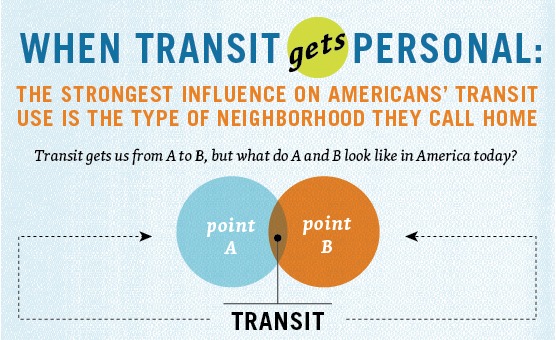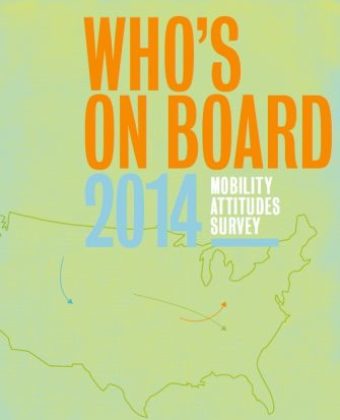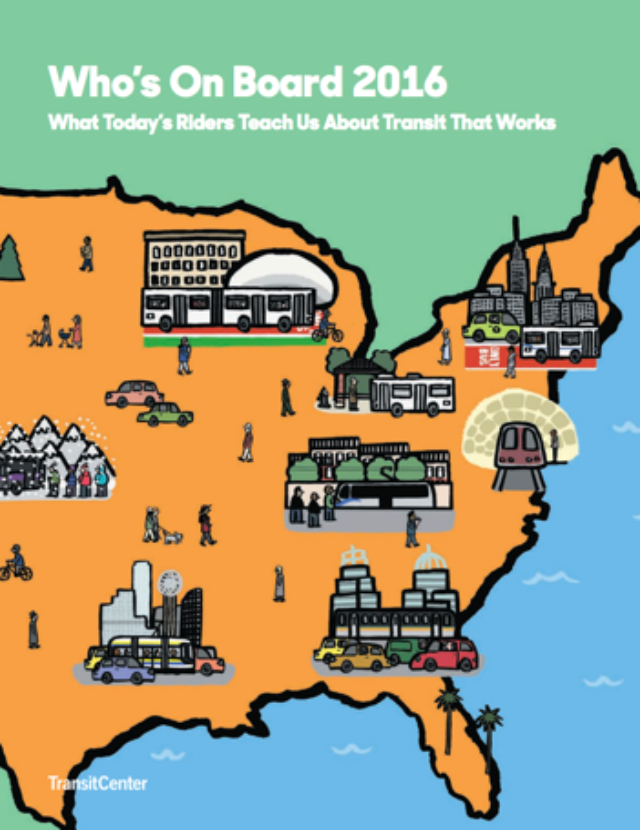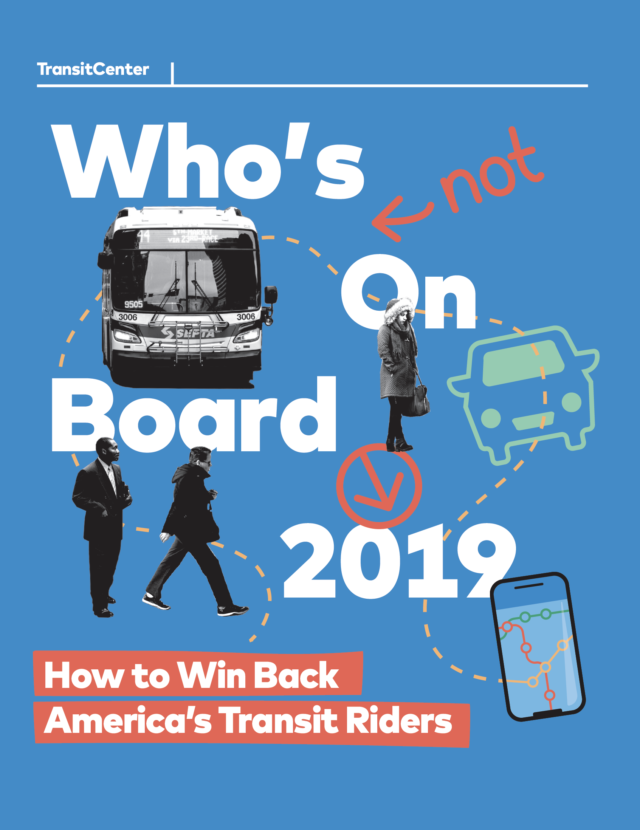Executive Summary
The goal of this study is a definitive understanding of the differences in attitudes and behaviors among the US population with respect to public transportation and neighborhood choice. We aim to understand which characteristics and beliefs are behind those differences. To that end, we conducted a large online survey (11,842 respondents) across 46 Metropolitan Statistical Areas (MSAs) in the United States. The selected MSAs span the full geography of the U.S. and include some cities with well-developed transit systems and others with less developed transit system. The sample also ensured minimum quotas for all age groups, allowing the study to compare different generations, geographies, and neighborhood types.
The results reveal that the most important factors in determining whether someone is at least an occasional transit user are:
- High population density of home neighborhood (positive effect)
- Being employed or a student (positive effect)
- Being an ethnic minority (positive effect)
- High-quality local transit (positive effect)
- High income (negative effect)
Surprisingly, education level and the presence of children in the home do not appear to have a strong association with transit use either way when the other variables are controlled for. This suggests that despite high rates of transit use in college, most former students do not continue to ride transit after that experience. People with kids, meanwhile, may be just as willing as others to take transit when it is available in their neighborhoods.
We are able to explore what factors generally draw people to public transportation. Travel time, reliability, and cost appear to be more important than “flashy” features like Wi-Fi. Additionally, people who are offered pretax transit commuter benefits by their employers are over five times as likely to take transit regularly as employed persons who are not receiving benefits.
The large sample size allows for comparisons across geography, age group, quality of local transit, levels of transit use, levels of population density, and other characteristics. We see the most variation across age groups. Behavior changes considerably along the age spectrum, even when controlling for other factors such as employment, household income, and neighborhood type.
Press
National Journal: Survey Finds Public Transit Riders Younger Than Expected, Sept. 22 2014
San Gabriel Valley Tribune: Millenials more likely to ride public transit than Baby Boomers, middle-aged Americans, Sept. 22 2014
Spokesman-Review (Spokane, WA): Younger people more likely to ride transit, report finds, Sept. 22 2014
Chicago Tribune: New parking policies driving transit-oriented development, Sept. 20 2014
CityLab: Millennials Love Transit Most, Boomers Still Stuck on Cars, Sept. 18 2014
Streetsblog USA: Why Transit Agencies Should Woo ‘Bohemian Boomers’ and ‘Metro Moms’, Sept. 18 2014
Salt Lake Tribune: Study: Denser development boosts transit ridership, Sept. 18 2014
Crain’s Business Cleveland: Cities of tomorrow will need strong public transportation systems to foster growth, Sept. 18 2014
WPTF (Raleigh, NC): The Bill LuMaye Show, Sept. 18 2014
Next City: What Millennials Want From Public Transportation, Sept. 18 2014
Mobility Lab: Public-Transportation Attitudes Examined in Major New TransitCenter Report, Sept. 18 2014
Houston Chronicle: National Study Finds Time Main Factor in Choosing Transit, Sept. 23 2014
Seattle Times: Do City Growth Strategies Subtly Discourage Car Ownership?, Sept. 26 2014
Builder Magazine: Public Transit Drives Americans’ Home-Buying Decisions, Sept. 25 2014
Deseret News: Walkable Communities can Help Old and Young alike Thrive, Sept. 28 2014
Who’s On Board
On January 12, 2015 TransitCenter presented the findings from Who’s On Board to The Funder’s Network. Starting at minute 22, the analysis includes how philanthropy and foundations can use this data to inform their role in transportation policy.
Shaping Point A and B
Transit not only takes you from point A to B, but shapes A and B and everywhere in-between. When it comes to living in their ideal neighborhoods, Americans are stuck. Find out what they want and why in our Neighborhood Infographic.

Appendix Tables
A full appendix, containing tabulations of all the attitudinal questions in the survey, can be found below. The data are broken out by transit quality (progressive vs. deficient) and region in the first set of tabulations and by environment (urban vs. non-urban) and age in the second set.
NEW REPORT REVEALS WHAT AMERICANS WANT FROM PUBLIC TRANSIT
First-ever national survey shows how regions & generations differ in attitudes toward transit & neighborhood choice
New York, NY — A first-of-its-kind study about attitudes toward transit use in the U.S. was released today by TransitCenter, a philanthropy committed to improving transit through innovation. The study – Who’s on Board: The 2014 Mobility Attitudes Survey – reveals that Americans from regions coast to coast think about and use public transit in remarkably similar ways. The report is the first to compare rider and non-rider attitudes by age, income, education, family status and ethnicity, and to examine both cities and suburban areas across various regions of the U.S.
“We commissioned this survey to take a deeper look at the public attitudes which are propelling recent increases in transit ridership,” said Rosemary Scanlon, Chair of TransitCenter and Divisional Dean of New York University’s Schack Institute of Real Estate. “As Millennials begin to take center stage in American life and the Baby Boom generation confronts retirement, both the transit industry and the real estate industry will need to adjust. Who’s On Board offers significant insights for professionals in both fields.”
The survey, the largest of its kind, sampled nearly 12,000 people from a selection of 46 metro areas across the country, including a mix of “transit progressive” cities (such as Miami, Denver, Seattle, and Minneapolis) and “transit deficient” cities (such as Tampa, Dallas, Fresno, and Detroit) revealing several surprising trends about today’s public transit commuters:
- Riders of all ages and in all regions place the greatest value on factors like travel time, proximity, cost, and reliability above safety, frequency, and perks like Wi-Fi when choosing whether or not to take public transportation.
- There is a high demand for quality public transportation nationwide, but such infrastructure is often missing in the places where people currently live; There is also a high, unmet demand for neighborhoods with a mix of housing, retail, and commercial space– 58 percent of survey respondents said their ideal neighborhood contained “a mix of houses, shops, and businesses,” but only 39 percent currently live in that type of neighborhood.
- People with children are just as likely to use transit as people without children, when factors like place of residence and age are accounted for. Where transit is effective, families will – and already do – ride transit to meet their daily needs. Places that want to use transit to attract young people should take heart: Transit will not lose its appeal for young residents starting families.
- Wealthy Americans want to ride public transportation too: In transit-rich “Traditional Cities” like New York City, Philadelphia, Washington, DC and Chicago, people with a $150,000 or greater salary are just as likely to ride public transportation as people with a $30,000 salary.
- Even though they grew up using public transit more than today’s youth, America’s Baby Boomers are mostly reluctant to use public transit now. Americans under 30 are 2.3 times more likely to ride public transit than Americans age 30-60, and 7.2 times more likely than Americans over 60. Even after controlling for other factors, older people are less likely to ride transit than younger people.
- “Traditional Cities” have the greatest share of transit users and commuters, followed by the West Coast cities, where 31% of people under 30 used public transit at least once a week.
“These findings provide concrete evidence of what many of us in the transit field have long suspected: there is a desire for reliable, quality transportation in communities across all regions of the U.S., and among riders of all ages, backgrounds and financial status,” said David Bragdon, Executive Director of TransitCenter. “Unfortunately, this desire is largely going unmet, to the detriment of many local economies. To serve – and attract – residents and workforces today and in the future, cities need to unite land use and transit planning to form comprehensive, innovative infrastructures that can support this demand.”
“Denser, mixed-use places are what most Americans want today, and will demand tomorrow,” said Christopher Leinberger, Chair of George Washington University’s Center for Real Estate and Urban Analysis and president of LOCUS, a national network of real estate developers who support sustainable growth. “High-quality transit can serve as a backbone for exactly this kind of development. While cities and suburbs that marry transit and mixed-use development reap the rewards, those that stick with a conventional suburban approach may find themselves stagnating.”
The report is based on a survey administered online to 11,842 respondents, in 46 Metropolitan Statistical Areas (MSA’s) who were selected and invited to participate based on age and geography (by home ZIP code). The survey will be updated and conducted regularly to track changes in transit rider attitudes and regional trends over time.
To speak with experts from TransitCenter about the report findings, please contact Steven Higashide at [email protected] or 646.435.0658 or contact Katie Andriulli at[email protected] or 917.438.4605.


